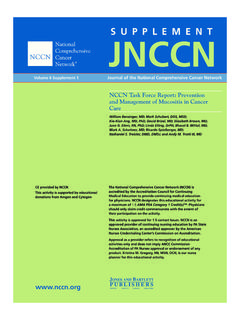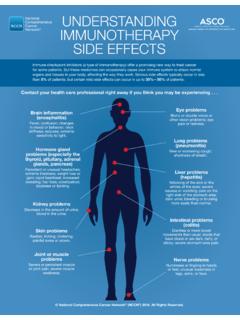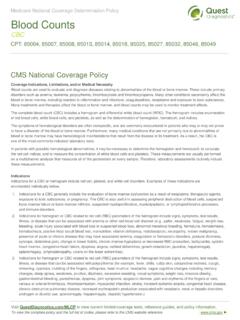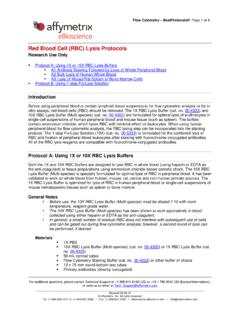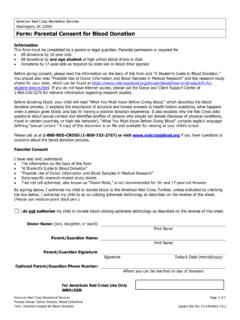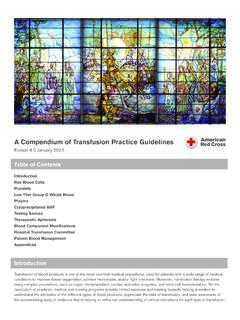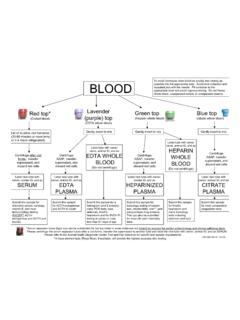Transcription of NCCN Guidelines for Patients
1 P. NC our le CN on ase .o lin co rg /p e s mp at u le NCCN ie rv t nt e s/ ey Guidelines su at FOR Patients . 2019 rv ey Myeloproliferative Neoplasms CLASSIC TYPES. Presented with support from: Available online at . Myeloproliferative Neoplasms It's easy to get lost in the cancer world Let NCCN Guidelines for Patients . be your guide 9 Step-by-step guides to the cancer care options likely to have the best results 9 Based on treatment Guidelines used by health care providers worldwide 9 Designed to help you discuss cancer treatment with your doctors NCCN Guidelines for Patients : Myeloproliferative Neoplasms, 2019 1. About These NCCN Guidelines for Patients are based on the NCCN Clinical Practice Guidelines in Oncology (NCCN Guidelines ) for Myeloproliferative Neoplasms (Version , September 4, 2019). 2019 National Comprehensive Cancer Network, Inc. All rights reserved. NCCN Foundation seeks to support the millions of Patients and their families NCCN Guidelines for Patients and illustrations herein may not be reproduced affected by a cancer diagnosis by funding and distributing NCCN Guidelines for in any form for any purpose without the express written permission of NCCN.
2 No Patients . NCCN Foundation is also committed to advancing cancer treatment one, including doctors or Patients , may use the NCCN Guidelines for Patients for by funding the nation's promising doctors at the center of innovation in cancer any commercial purpose and may not claim, represent, or imply that the NCCN research. For more details and the full library of patient and caregiver resources, Guidelines for Patients that have been modified in any manner are derived visit from, based on, related to, or arise out of the NCCN Guidelines for Patients . The NCCN Guidelines are a work in progress that may be redefined as often National Comprehensive Cancer Network (NCCN ) / NCCN Foundation . as new significant data become available. NCCN makes no warranties of any 3025 Chemical Road, Suite 100. kind whatsoever regarding its content, use, or application and disclaims any Plymouth Meeting, PA 19462.
3 Responsibility for its application or use in any way. NCCN Guidelines for Patients : Myeloproliferative Neoplasms, 2019 2. Supporters Sponsored by MPN Research Foundation The NCCN Guidelines for myelofibrosis provide clarity for physicians and Patients about their options and what to expect upon diagnosis with PV, ET or MF. These are long awaited by the patient community and we are so glad to see it come to fruition. Endorsed by Leukemia & Lymphoma Society (LLS). LLS is dedicated to developing better outcomes for blood cancer Patients through research, education and patient services and is happy to have this comprehensive resource available to Patients . MPN Cancer Connection MPN Cancer Connection (MPN-CC) recognizes MPN Patients are in fact cancer Patients and should have full access to programs, benefits and resources available in your area. MPN-CC is pleased to support the comprehensive resource provided by the NCCN Patient Guidelines for Myeloproliferative Neoplasms (MPNs).
4 MPN Education Foundation Educating physicians and Patients about evidence-based diagnostic algorithms and treatment for the myeloproliferative neoplams will benefit both, and will improve patient access to those treatments. The MPN Education Foundation is pleased to endorse this landmark effect on behalf of those we serve. NCCN Foundation relies solely on donations to fund the NCCN Guidelines for Patients . DONATE NOW. To make your gift, visit NCCN Guidelines for Patients : Myeloproliferative Neoplasms, 2019 3. NCCN Guidelines for Patients : Myeloproliferative Neoplasms, 2019 4. Myeloproliferative Neoplasms Contents 6 MPN basics 12 Tests for MPN. 21 Polycythemia vera 30 Essential thrombocythemia 39 Myelofibrosis 51 Making treatment decisions 60 Words to know 64 NCCN Contributors 65 NCCN Cancer Centers 66 Index NCCN Guidelines for Patients : Myeloproliferative Neoplasms, 2019 5. 1. MPN basics 7 blood 8 blood cancers 8 Classic MPN types 10 Health risks 11 Review NCCN Guidelines for Patients : Myeloproliferative Neoplasms, 2019 6.
5 1 MPN basics blood Myeloproliferative neoplasms (MPNs) blood cells are a type of blood cancer. This chapter As shown in Figure 1, there are 3 main types reviews some basics about MPNs, such of blood cells : as the 3 classic types. Red blood cells (also called erythrocytes). White blood cells (leukocytes), which include granulocytes, monocytes, and blood lymphocytes Platelets (thrombocytes). To learn about blood cancers, you first must know about blood . blood is one of the fluids in blood cells have important jobs. Red blood the body. It consists of blood cells that move cells carry oxygen throughout the body. White within plasma. Plasma is mostly water. blood cells help fight germs. Platelets help control bleeding. blood stem cell Figure 1. blood cells Myeloid Lymphoid progenitor cell progenitor cell There are three main types of blood cells . These types are red blood cells , white blood cells , and platelets.
6 blood stem cells Megakaryoblast are the cells from which all Erythroblast Myeloblast Lymphoblast blood cells are formed. They go through a series of changes to Megakaryocyte become mature blood cells . Illustration Copyright 2020 National Comprehensive Cancer Network (NCCN ). Red blood cell White blood cells White blood cell Erythrocyte Granulocyte Monocyte Lymphocyte Platelet Thrombocyte NCCN Guidelines for Patients : Myeloproliferative Neoplasms, 2019 7. 1 MPN basics blood cancers | Classic MPN types Your blood cells don't live forever. Many have a blood cancers short lifespan. blood cells are being replaced in your body all the time. blood cancers are a group of cancers. They form from blood cells in bone marrow. blood How blood cells form cancers include leukemia, myelodysplastic Most blood cells are formed in bone marrow. syndromes (MDS), and myeloproliferative Bone marrow is the sponge-like tissue in the neoplasms (MPNs).
7 Center of most bones. MPN. Your bone marrow contains blood -forming MPNs form from blood stem cells within the cells . These cells are called blood stem cells myeloid cell line. Myelo means marrow. or hematopoietic stem cells . They are the cells Proliferative means growing and refers to from which all blood cells are formed. making too many cells . A neoplasm is any abnormal growth. blood stem cells can make exact copies of themselves. They can also make new cells that MDS are also cancers of blood stem cells . are a step closer to being mature blood cells . Unlike MPNs, people with MDS don't have These cells are called progenitor cells . enough blood cells . Unlike stem cells , progenitor cells are set to become a certain type of blood cell. There are 2 types of blood progenitor cells : Classic MPN types Myeloid progenitor cells There are many types of MPNs. This book is Lymphoid progenitor cells about treatment for the 3 classic types.
8 The classic types are: Myeloid progenitor cells change and become Polycythemia vera (PV), red blood cells , platelets, and white blood cells . These white blood cells are called granulocytes Essential thrombocythemia (ET), and and monocytes. Granulocytes include Primary myelofibrosis (PMF). neutrophils, eosinophils, and basophils. Chronic myeloid leukemia (CML) is a type of Lymphoid progenitor cells change and become MPN. Some people call it a classic MPN, but a type of white blood cell called lymphocytes. it is often discussed by itself. Its treatment is There are 3 types of lymphocytes. They are based on a cancer marker that the other classic B cells , T cells , and natural killer cells . MPN types do not have. NCCN Guidelines for Patients : Myeloproliferative Neoplasms, 2019 8. 1 MPN basics Classic MPN types . Polycythemia vera PV causes too many red blood cells . High levels of white blood cells and platelets may also be present.
9 The red blood cells build up in bone marrow and blood . As a result, blood A rare disease isn't so rare when becomes thicker than normal. you have one. Essential thrombocythemia ET causes too many megakaryocytes and Jean platelets. Megakaryocytes are a type of blood cell within bone marrow. Platelets are tiny Survivor, Polycythemia vera pieces of megakaryocytes. Having too many platelets is called thrombocythemia. Essential . means the thrombocythemia is caused by a problem in the blood cell-making process within bone marrow. Primary myelofibrosis Myelofibrosis (MF) is scarring of the bone marrow. If you haven't had another type of MPN, MF is called primary myelofibrosis or PMF. In early phases of PMF, scarring may have not yet formed. When scarring forms, the scar tissue may replace bone marrow. With less bone marrow, the number of blood cells may drop. As a result, the spleen and liver may begin to make blood cells and grow larger in size.
10 These organs may also enlarge because they trap abnormal blood cells . MF can also occur if you have PV or ET. If you have PV that became MF, it is called post-PV myelofibrosis. If you have ET that became myelofibrosis, it is called post-ET. myelofibrosis.. NCCN Guidelines for Patients : Myeloproliferative Neoplasms, 2019 9. 1 MPN basics Health risks Health risks sometimes be deadly. blood clots can cause a pulmonary embolism or stroke. See Figure 2. MPNs are chronic blood cancers. This means they do not go away on their own. Without Other cancers treatment, MPNs get worse over time. It can MPNs can transform. ET and PV can evolve take many years for MPNs to cause symptoms into MF. Although rare, MPNs can change into or serious health conditions. acute myeloid leukemia (AML). Symptoms Potentially shorter lifespan People may have symptoms for a long time MPNs are slow-growing cancers. Many people before they learn they have an MPN.



